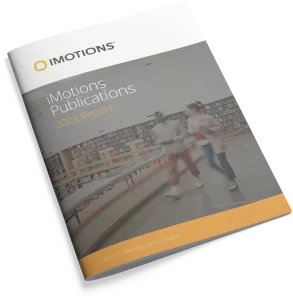-
Association of intensity and dominance of CEOs’ smiles with corporate performance
This study investigated whether the facial expressions of chief executive officers (CEOs) are associated with corporate performance. A photograph of the CEO or president of each company that appeared on the Fortune Global 500 list for 2018 was taken from the company’s official website. The smile intensity and action unit activation in each face were […] -
Being facially expressive is socially advantageous
Individuals vary in how they move their faces in everyday social interactions. In a first large-scale study, we measured variation in dynamic facial behaviour during social interaction and examined dyadic outcomes and impression formation. In Study 1, we recorded semi-structured video calls with 52 participants interacting with a confederate across various everyday contexts. Video clips […] -
Attention Level Evaluation in Children With Autism: Leveraging Head Pose and Gaze Parameters From Videos for Educational Intervention
In children with autism spectrum disorders (ASDs), assessing attention is crucial to understanding their behavioral and cognitive functioning. Attention difficulties are a common challenge for children with autism, significantly impacting their learning and social interactions. Traditional assessment methods often require skilled professionals to provide personalized interventions, which can be time consuming. In addition, existing approaches […] -
Work-in-Progress-Exploring the Therapeutic Potential of Fear Conditioning Using Virtual Reality for Victims of Gender-Based Violence: A Physiological Computing Approach Using Sweat-Sensing Bodysuit
Gender-based violence (GBV) is a deeply entrenched issue with widespread effects that go beyond the physical to profoundly affect victims’ psychological well-being. Those subjected to GBV are at risk of developing several mental health conditions, such as post-traumatic stress disorder (PTSD), anxiety, and depression. These conditions are often intensified by physiological symptoms, including hyperhidrosis, or […] -
An Attractiveness Bias? How Women Entrepreneurs’ Physical Appearance Affects Men Investors
Women founders frequently appear to encounter varied and often negatively biased decisions from investors. Our study builds on the theoretical and practical interest in understanding whether and how biases against women entrepreneurs are attributed to men investors’ cognitive and physiological (i.e., hormonal) responses to the women’s physical appearance. Using a cross-sectional research design, we recruited […] -
Persona-Based and Scenario-Based Design of Virtual and Physical Companion Robots with Varied Kawaii (Cute) Attributes
In recent years, concerns about anxiety and other mental health issues in university students have been widely reported. Some college campuses have seen increased student requests to bring emotional support animals to campus, although these animals are hard to care for in shared living spaces that are common in college settings. This paper reports on […] -
In-Lab and Remote webcam-based Respiration: A promising candidate for neuromarketing?
Advancements in biosensor technologies are sought after to enable innovation in the field of neuropsychology and emotional research. Galvanic skin response, facial expressions analysis, as well as respiration have been used in the past to measure implicit emotional reactions. While some of these focus on either the valence or intensity of emotions, respiration shows promise […] -
FUSE- FrUstration and Surprise Expressions: ASubtle Emotional Multimodal Language Corpus
This study introduces a novel multimodal corpus for expressive task-based spoken language and dialogue, focused on language use under frustration and surprise, elicited from three tasks motivated by prior research and collected in an IRB-approved experiment. The resource is unique both because these are understudied affect states for emotion modeling in language, and also because […] -
From Eye Movements to Personality Traits: A Machine Learning Approach in Blood Donation Advertising
Blood donation heavily depends on voluntary involvement, but the problem of motivating and retaining potential blood donors remains. Understanding the personality traits of donors can assist in this case, bridging communication gaps and increasing participation and retention. To this end, an eye-tracking experiment was designed to examine the viewing behavior of 75 participants as they […] -
Measurement of Visitors’ Subjective and Objective Emotional Response to Congestion in Public Spaces
Research on the ties between congestion and visitors’ experiences in a destination has primarily used subjective methods. The current study proposes that the emotional, subjective visitor response to congestion be measured alongside the objective experience, in real time and real-world conditions. To do so, advanced tracking methods in time and space (GPS) were combined with […]
Research Report 2024
In-depth look at the scientific landscape as powered by iMotions software, showcasing groundbreaking research and the impact of our tools in various scientific and industrial fields.

iMotions Science Resources
Looking for white papers, validation reports or research show casing iMotions Multimodal capabilities?
Share Your Research

850+ universities worldwide with an iMotions human behavior lab
73 of the top 100 highest ranked universities
710+ published research papers using iMotions
iMotions is used for some of the most interesting human behavior research studies carried out by top researchers around the world. Contact us to have your publication featured here.
The authors of these publications have used iMotions as a software tool within their research.
“Software should be cited on the same basis as any other research product such as a paper or a book; that is, authors should cite the appropriate set of software products just as they cite the appropriate set of papers” (Katz et al., 2020).
We therefore encourage you to cite the use of iMotions where appropriate.
How to cite iMotions
APA
iMotions (10), iMotions A/S, Copenhagen, Denmark, (2024).
Note: adjust the version and year where relevant.
5 Most Popular Blogs
Publications
Read publications made possible with iMotions
Blog
Get inspired and learn more from our expert content writers
Newsletter
A monthly close up of latest product and research news


